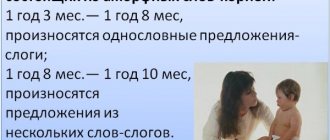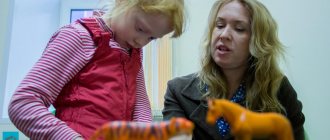Development of speech understanding. Consultation on speech therapy on the topic
Development of speech understanding.
An important area of pedagogical work with young children is the creation of conditions for speech development. In this area, several specific tasks stand out: the development of active speech, speech understanding, the formation of phonemic hearing, the development of speech as a means of controlling one’s behavior (that is, the planning and regulatory functions of speech).
To develop understanding of speech, it is necessary to awaken and maintain children’s interest in audible speech and develop the ability to listen to the speech of an adult. Developing understanding of speech implies establishing an adequate connection between a word and an object and an action. In this process, an important role is played by encouraging children to carry out adult verbal instructions of varying complexity: from the simplest one-step ones for young children (“give”, “show”, “take”, “bring”, etc.) to more complex (as the child gets older) two- and three-step instructions.
There are several levels of development of speech understanding in children with speech underdevelopment:
- Zero: a child with intact hearing does not perceive the speech of others, sometimes reacts to his name, less often to intonations of prohibition or encouragement;
- Situational: the child understands requests related to the everyday objective world. He knows the names of loved ones and the names of his toys, can show body parts of himself, his parents, or a doll, but upon verbal request he does not distinguish between images of objects, toys, that are well known to him.
- Nominative: the child is well versed in the names of objects depicted in the pictures, but has difficulty naming the actions depicted in the plot pictures. Completely does not understand questions of indirect cases (With what? To whom? With whom?...)
- Predicative: the child knows many names of actions, easily navigates questions of indirect cases posed to the objects of actions depicted in plot pictures, distinguishes the meanings of several simple prepositions (put on the box, in the box, near the box). Does not distinguish between grammatical forms of words.
- Dissected: the child distinguishes changes in meanings introduced by individual parts of the word (morphemes) - inflections (endings), prefixes, suffixes.
When does a child’s understanding of speech begin to develop? From 5-6 months, children become more active. It is during this age period that the main task is to develop children’s understanding of speech and the ability to repeat syllables after adults. The mother should name the objects surrounding the child and the actions performed by the child or the mother herself. Thus, she combines objects and actions with their verbal designation. You can play the following games:
“Where is Lyalya?” Target. Develop the ability to find a named object using a word (after 7 months). For the lesson, large story toys are used (doll, cat, dog, rooster, hare, etc.), which must always be in the same place so that the baby can see them all the time.
"Rhymes" Purpose. Develop an understanding of the names of simple movements and imitation of movements, for example, “Okay”, “Goodbye”, “Give me a pen” (from 7 months).
"Roll Call" Purpose. Development of the articulatory apparatus and the ability to imitate (from 7-8 months).
"Hide and Seek" Goal. Introduce the child to his name and the names of other children and adults (from 8-9 months). “Where is Masha? No Masha."
From 9-10 months to 1 year, the number of words and sentences a child understands increases. You should teach the child to perform certain movements according to the word (sit down, stand up) and perform a number of different actions with objects (put one cube on another, remove and put a ring on a stick - “put it on,” “take it off,” “put it on”).
It is necessary to create a speech environment. This means the following: you need to constantly talk to the child, repeatedly talking through all routine moments (dressing and undressing, washing, eating, walking, getting ready for bed), and various everyday situations (putting toys in places, preparing food, clearing the table, etc. .). The same work should be done while playing with toys and pictures, and while reading books.
At the same time, the adult speaks in simple short sentences of 2-4 words, uses the same phrases several times, pauses, uses different intonations, and different voice strengths. Words are pronounced clearly, with emphasis on the stressed syllable, for which the stressed syllable is slightly stretched.
An adult often turns to the child and asks questions. But you should not demand an immediate answer. Thus, the adult asks a question, pauses, then answers the question himself.
In the process of correctional classes for the development of speech understanding, the main task is the accumulation of children’s passive vocabulary: words - objects, words - actions, as well as words denoting certain phenomena and states.
Groups of words suggested for memorization.
1. Subject dictionary.
Toys: ball, cube, car, doll, bear, bunny, ball, spinning top, bucket, shovel, pencils, book, etc. Parts of the body, face: legs, arms, belly, back, finger, head, neck, hair, eyes , ears, mouth, lips, teeth, nose, cheeks, eyebrows, forehead. Clothing and footwear: hat, scarf, mittens, jacket, coat, dress, skirt, jacket, shirt, trousers, tights, briefs, T-shirt, socks, slippers, boots, shoes, sandals, etc. Toilet items: soap, toothbrush, toothpaste, sponge, towel, comb, handkerchief, etc. House, apartment: house, door, lock, key, stairs, elevator, window, kitchen, room, bathroom, lamp, floor, ceiling, wall, etc. Furniture: table, chair, sofa, bed, wardrobe, shelf, hanger, etc. Household items: TV, telephone, clock, stove, refrigerator, fork, spoon, plate, cup, blanket, pillow, mirror, etc. Food and dishes : bread, bun, cheese, sausage, sausages, milk, butter, sour cream, cottage cheese, yogurt, cookies, juice, egg; porridge, soup, salad, sandwich, tea, compote, etc. Vegetables and fruits: cabbage, potatoes, carrots, onions, cucumber, tomato; orange, banana, apple, pear, plum, etc. Plants: tree, bush, grass, flowers, berries, etc. Names of animals and birds that the child often sees: dog, cat, bird, dove, sparrow, crow, horse, etc. etc. Separate names of objects of surrounding life: street, road, traffic light, cars, plane, swing, slide, park, etc. Separate names of phenomena of surrounding life: water, earth, sun, sky, rain, snow, night, day, etc.
2. Verb dictionary.
The child’s own actions: walks, sits, stands, runs, jumps, sleeps, eats, plays, draws, builds, walks, rolls, washes, bathes, dresses, undresses, combs his hair, carries, falls, screams, speaks, sweeps, wipes and etc. Names of actions that people close to the child perform: reads, writes, draws, cleans, washes, irons, cooks, fries, sweeps, etc. Other actions: the phone rings; the car drives and hums; The plane is flying; leaves are falling, etc.
3. Adjectives, adverbs.
Names of some sensations and states: sweet, salty, sour, wet; cold, warm, hot, painful, tasty.
The name of some concepts: big, small; a lot, a little.
Sequence of work on speech understanding.
The basic rule that is absolutely necessary to follow for successful understanding of speech: the correlation between a word and what it means should be as obvious as possible for the child.
Classes begin with the child being taught to understand a word in a certain situation. Usually these are words - nouns, then verbs, then simple signs. Acquaintance occurs gradually, preferably in a specially organized game, then it is consolidated in everyday life. The most convenient and interesting game is hide and seek. During this game, an object, for example, a toy, appears and disappears multiple times while naming it at the same time.
Dictionary accumulation sequence:
Nouns.
- The object is presented and named.
- The child is introduced to the purpose of the object.
- A game is organized during which the object is called repeatedly (for example, hide and seek: “Here is the ball! They hid the ball! There is no ball! Where is the ball? Here is the ball! Throw the ball to mom!”).
- A child uses a word to find an object when choosing from two.
- The child finds an object upon request, choosing it from a larger number of objects.
- To form a concept, the child is offered similar, but different in color, size, texture objects and their images.
- The name of the object is included in games and songs, and work begins on including the word in the child’s active vocabulary.
Note: we proceed to each subsequent point only after the child copes with the previous one.
Verbs.
- Introducing the child to an action or a picture depicting an action. For example, familiarity with the verb “eats”.
- A game is organized, during which this action is played out many times and called (“the bear eats, the bunny eats, the doll eats”).
- The child chooses one of two actions (the doll eats - the doll sleeps).
- Choose from more options.
- Incorporating words into everyday life and games.
- Including a word in the active dictionary.
Acquaintance with other parts of speech occurs using a similar method.
Working on a proposal:
Types of simple sentences:
- Instructions: Give me the machine.
- Descriptions: Give me a big car.
- Questions: Do you want a car?
- Negatives: Is this a machine? (show the cube).
Complication occurs after working out a simple sentence. The difficulty will depend on the number of words that affect understanding, the so-called keywords.
When working on understanding speech, it is necessary to use sentences of different types, the words in them must perform different functions. For example,
- Accessory: “Wash the car plate.”
- Moving an object: “Put the car on the table.”
- Passing the object: “Give me the ball.”
- An action performed on a subject or object: “Pet the dog.”
- Questions: “Where is the bear?”
- Negations: “Show me a bear that doesn’t lie.”
So, to develop speech understanding it is necessary:
- help the child establish connections between objects and actions, on the one hand, and the words denoting them, on the other;
- expand the child’s orientation in the environment;
- teach your child to recognize familiar objects even in unfamiliar surroundings;
- teach the child to recognize objects in nature and in pictures that are similar, but different in color, size or shape;
- encourage the child to carry out various instructions at the request of an adult (bring, show);
- teach the child to understand the content of simple sentences;
- teach the child to understand the display of simple plots, accompanied by the words of an adult.
4.1. The customer undertakes:
4.1.1. Pay for Services in the manner, amount and terms stipulated by the Agreement and the terms published on the Site, as well as in any other information channel for disseminating information.
4.1.2. Properly comply with all conditions and requirements necessary for the provision of the Service specified on the Site, as well as in any other information channel for disseminating information.
4.1.3. Comply with the Contractor's requirements, observe discipline and generally accepted standards of behavior, in particular, show respect for the Contractor's staff and other Customers, and not infringe on their honor and dignity.
4.1.4. Promptly transfer all necessary documents and information to the Contractor.
4.1.5. Compensate for damage caused to the Contractor's property in accordance with the legislation of the Russian Federation.
4.1.6. Do not use information received from the Contractor and during the receipt of the Service from the Contractor in ways that could lead to damage to the interests or damage the reputation of the Contractor.
4.1.7. Immediately inform the Contractor about all circumstances that may affect the Parties’ performance of their obligations;
4.1.8. Independently and timely familiarize yourself with the dates, costs, and conditions for the provision of Services;
4.1.9. Attend all classes included in the scope of the Services provided, as well as attend all necessary medical consultations recommended by doctors and generally accepted for a child of a certain age. This is one of the mandatory conditions for the continued provision of the Services;
4.1.10. Notify the Contractor of changes in your contact information in writing immediately from the moment of such changes;
4.1.11. In writing (including via contact e-mail) by sending a corresponding statement to the Contractor, notify the Contractor of the refusal to participate in classes in the manner established by Chapters 10 and 5 of this Agreement.
4.1.12. Do not make photo, audio, or video recordings of the provision of Services without written consent from the Contractor.
4.1.13. Use any handout materials, in whole or in part, including photos, audio, and video recordings only for personal use. All materials are protected by copyright and the legislation of the Russian Federation.
4.2. The Contractor undertakes:
4.2.1. Organize and ensure proper provision of Services in accordance with the conditions published on the Site and in the Offers.
4.2.2. Post changes to the schedule in advance on the Site, as well as in any other information distribution channel, and comply with the Schedule posted on the Site, as well as in any other information distribution channel.
4.2.3. Provide oral and written advice to the Customer, including for an additional fee, on additional questions of the Customer. The complexity of the issue, volume, and timing of consultation are determined separately in each specific case.
4.2.4. Compensate for damage caused to the Customer's property in accordance with the legislation of the Russian Federation.
4.2.5. Involve professionals in the topic and field, as well as other persons necessary to provide the Services, in the provision of Services.
4.3. The customer has the right:
4.3.1. Require the Contractor to provide information on issues of organizing and ensuring proper provision of the Services.
4.3.2. Require proper and timely provision of Services by the Contractor.
4.3.3. Refuse to perform the Agreement in the manner and under the conditions specified in Chapter 10 of this Agreement.
4.3.4. Contact the Contractor for all questions related to the provision of Services.
4.3.5. Express your wishes to improve the quality of service provision.
4.3.6. Receive special discounts and payment terms in cases separately agreed with the Contractor.
4.3.7. Has the right to receive funds for classes not attended by agreement with the Contractor, in the event of the occurrence of objective circumstances that insurmountably prevent attending or listening to courses/events by prior agreement with the Contractor, in particular in the event of identifying contraindications to receiving services, confirmed by documentary opinions of doctors.
4.4. The performer has the right:
4.4.1. Independently determine the forms and methods of providing Services, taking into account the requirements of the legislation of the Russian Federation, as well as the terms of the Agreement.
4.4.2. Independently identify and attract specialists providing Services and, at its own discretion, distribute work between them.
4.4.3. Demand payment for Services provided or provided.
4.4.4. Refuse to perform the Agreement in the manner and under the conditions specified in Chapter 10 of this Agreement.
4.4.5. Receive from the Customer any information necessary to fulfill its obligations under the Agreement. In case of failure to provide information, or incomplete or incorrect information provided by the Customer, the Contractor has the right to suspend the performance of its obligations under the Agreement until the required information is provided.
4.4.6. Take photographs, video and (or) audio record events related to the provision of Services. The Customer gives his consent to the Contractor to carry out the above actions and grants the Contractor the right to disclose, publish on the Site and in other sources, bring to the public’s attention, make available to an indefinite number of persons, distribute, reproduce, copy, edit and otherwise use photographs, audio and video recordings with his image and (or) voice, including transferring all copyright, exclusive and other rights to such works with his participation or image to the Performer in full (alienation agreement).
4.4.7. Cancel or postpone events related to the provision of Services to another period in the absence of more than 50% (Fifty percent) of Customers, if the Services are provided jointly in a group with other Customers. Money for Services not provided will be refunded in full.
4.4.8. Temporarily suspend (and, if necessary, reschedule the Lesson) the provision of Services to the Customer for technical, technological, organizational or other reasons that impede the provision of Services beyond the control of the Contractor, until such reasons are eliminated. If such circumstances arise, the Contractor has the right to postpone the lesson, including directly on the day of its holding.
4.4.9. Provide access to classes in accordance with the schedule, unless otherwise provided by additional agreements.
4.4.10. Close access to the Site and other resources, terminate the provision of Services without the right to a refund in case of violation by the Customer of the rules of conduct, in particular violation of the rules specified in clause 4.1.3. Violation also means the Customer’s use of profanity during the provision of the Service, including online, general calls for distrust of the Contractor in person and on the Internet, advertising of third-party Internet resources on the Site and on the Contractor’s social networks, insults and threats against the Contractor’s employees, attempts hacker attacks, the fact of violation by the Customer of exclusive copyright and/or property rights, as well as intellectual property rights of the Contractor. Report all violations through social networks and other means of information.
4.4.11. Close access to the Site, other resources and materials, terminate the provision of Services unilaterally without the right to a refund in case of violation by the Customer of the rules set out in clause 14.6.2, as well as for any violation by the Customer of copyright, exclusive and other intellectual rights Performer.
4.4.12. Refuse the Customer to provide Services if the latter does not receive payment for the relevant Services before the start of its provision.
4.4.13. Refund to the Customer only for unattended classes/events by prior agreement if there are objective circumstances that insurmountably prevent attending and/or listening to classes/events/activities.
Levels of speech understanding in children
Let's look at how a child's understanding of speech develops:
- Newborn up to 1 month. At every moment when he is awake, the baby uses his senses in order to obtain new information about the world around him. While he does not know everything that adults and older children use to interpret their perceptions, he builds up this stock of knowledge every day. The baby is emotionally attuned to the people closest to him. He responds to the tone of your voice, your smile and the warmth of your touch when you feed him. He creates his version of reality from how you react to him and feels safe because you come to him when he cries, look into his eyes with love and feed him when he is hungry. As his motor skills develop, crumbs improve memory and ability to speak, increase attention span and improve social skills.
- 2 – 3 months. At this age, the baby continues to collect information. His favorite pastime is to watch what is happening around him. Now he knows that you will soothe, feed and play with him when he needs it. Also, the baby will delight you with his first real smile and he will like the way you react to it. He will understand that smiling is one way of telling you that he likes everything. And by 3 months, the baby will add some grunts and gurgling sounds to his smile, starting a primitive form of conversation with you.
- 4 – 7 months. Now the child knows his name and understands that you are addressing him when you say it out loud, and may even answer by turning his face to you. He also continues to navigate by your voice: when you talk to him joyfully, he answers joyfully, and if If you speak to him sharply and seriously, he will get upset or even cry. In addition, the baby will begin to distinguish strangers from relatives. He may cry if you let someone else he doesn't know hold him.
- 8 – 12 months. By this time, the baby is already beginning to understand simple instructions. Say “No” when she tries to touch the socket, for example. She will stop and look at your face, perhaps even shake her head in response. The baby is testing your reaction to her behavior not because she is naughty, but in order to better understand how the world around her works. She throws food on the floor to see what you will do, and then stores your reaction in her memory. Later, she will do this trick again to see if you react the same way. In addition, the baby will begin to associate gestures with certain actions and words. For example, she may wave her hand when someone leaves the room or shake her head negatively to refuse food.
- 13 – 18 months. By 18 months, your baby should understand and use some words. In simple terms, he will understand the meaning of a word before he can use it in his speech. He will also be able to follow your instructions, even if they involve two separate actions. For example, take these blocks and put them in your toy chest.
- 19 – 23 months. The child will begin to realize that his desires may not correspond to yours. Therefore, he will try to make himself known, for example, by resolutely hiding his hands under his armpits when you want him to hold your hand. The baby will understand concepts such as space and measurement. This means that he can now distinguish a circle from a square and assemble a puzzle by placing each piece in its designated place in the sorter. He will also continue to figure out how everything around him works. The child will find out that by pressing the lever, a clown will jump out of the box. This skill will come in handy when he is ready to go to the toilet. In particular, before he can stop wearing diapers, he must make the connection between his bowel movements and using the potty, and understand that when he pulls the toilet handle to flush the toilet, his feces will disappear into the drain. Remember that at this age he is just beginning to learn about this process.
- 24 – 36 months. Now the child already understands speech well and knows many more words than he can say. Developmental experts say that most 2-year-olds have a vocabulary of at least 50 words, increasing to 200 by age 3. As language acquisition progresses, the child can now turn his attention to more complex concepts that include emotions . Between the ages of 2 and 3, he will understand the basic components of a relationship: love and trust. Because of the way he was treated in the first years of his life - showered with love, all his needs met, and provided security - he learned that you and the rest of the family care about you always protect him. This helped him become confident and optimistic.
By observing how you go about your day, your baby will begin to understand some of the more complex aspects of everyday life, such as grocery shopping and telling time with a clock. He will also gain a deeper understanding of how he should treat other people. Therefore, if you want your child to grow up to be a kind and compassionate person, make sure that you treat him and other people in this way.
How speech is formed
Left-handedness and right-handedness are important in the formation of speech . Right-handers and left-handers develop speech differently. If in an adult literate person (right-handed) the cortical fields of the middle parts of the left hemisphere play a leading role in the brain support of speech processes, then in children (left-handed and right-handed) who are not yet literate (up to 5-6 years), speech processes (understanding of oral speech) and active speech) are provided by the brain structures of both the left and right hemispheres. In left-handed adults, active participation in speech and perception of the world occurs when the right hemisphere is interested.
Thus, the brain organization of higher mental functions changes during the life and development of a person, and also differs in left-handed and right-handed people. A preschool child fills entire hours with speech to himself. He develops new connections, new relationships between functions, ones that were not given in the initial connections of his functions.
This is of particular, central importance for mastering one’s own behavior, such as self-regulation and self-control; problems with these functions (disinhibition, hyperactivity, or, conversely, lethargy) directly interfere with the development of speech.






